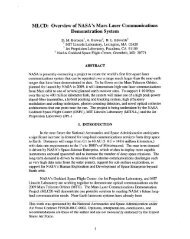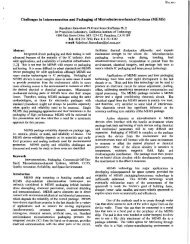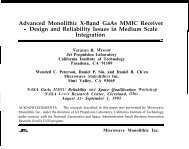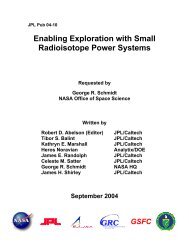f - NASA Jet Propulsion Laboratory Technical Reports Server
f - NASA Jet Propulsion Laboratory Technical Reports Server
f - NASA Jet Propulsion Laboratory Technical Reports Server
Create successful ePaper yourself
Turn your PDF publications into a flip-book with our unique Google optimized e-Paper software.
VIGILANTE - System Description and First Experiment Approach and Results<br />
Steven Suddarth', Michael Brewer', Suraphol Udomkesmalee', Carl Christian Liebe', Curtis Padgett',<br />
Hung Vo' and Larry Avril'<br />
'<strong>Jet</strong> <strong>Propulsion</strong> <strong>Laboratory</strong>, 4800 Oak Grove Dr, Pasadena CA 91 109-8099<br />
'Ballistic Missile Defense Organization, Washington, DC 20301<br />
ABSTRACT<br />
The VIGILANTE project is a planned vision system capable of tracking and recognizing targets in real time, on a small<br />
airborne platform. The project consists of two parts, 1) the Viewing ImagedGimballed Instrumentation <strong>Laboratory</strong><br />
(VIGIL), which is an infrared and visible sensor platform with appropriate optics and 2) the Analog Neural Three-<br />
dimensional processing Experiment (ANTE), a massive parallel, neural based, high-speed processor.<br />
The VIGIL sensors are mounted on a helicopter. VIGIL consists of an Optical Bench containing a visible camera, a Long<br />
Wave Infrared (LWIR) camera and a two axes gyro stabilized gimbaled mirror. The helicopter is also equipped with<br />
Global Position System (GPS) and an Inertial Measurement Unit (IMU) for attitude and position determination and two<br />
video links for ground based image collection. Finally, a jet powered, radio controlled VIGILANTE Target Vehicle<br />
(VTV) has been manufactured and equipped with GPS. In the first stages of the project, the VIGIL system is mounted in a<br />
Hughes 500 helicopter and is used to acquire image sequences of the VTV for training and testing of the ANTE image<br />
recognition processor. Based on GPS and IMU input, the gimbal is pointed toward the VTV and acquires images.<br />
This paper describes the VIGIL system in detail. It discusses the overall approach for the first flight experiment, the results<br />
of the experiment and the follow-on experiments that demonstrate real-time target recognition and tracking.<br />
Keywords: VIGILANTE, Airborne sensor, Attitude determining System, Field experiments.<br />
1. INTRODUCTION<br />
Small air and space borne systems capable of autonomous acquisition and identification of hostile targets (e.g., cruise<br />
missiles, missile launchers etc.) will become an essential component of the Ballistic Missile Defense Organization's<br />
(BMDO) planned defensive mechanisms. Such Automatic Target Recognition (ATR) capability could greatly increase the<br />
capabilities of interceptors (for cruise and ballistic missiles), surveillance platforms (for missile launchers), and ground-<br />
based fire control.<br />
The VIGILANTE project at <strong>Jet</strong> <strong>Propulsion</strong> <strong>Laboratory</strong> (JPL) [l] provides a low-cost airborne platform that combines new<br />
sensors with advanced neural network processing algorithms for detection, recognition and tracking of missile threats. The<br />
project consists of two parts, the airborne VIGIL platform and the ANTE ATR processor.<br />
VIGIL Wiewing Jmager/Qimballed Instrumentation <strong>Laboratory</strong>) is a helicopter-based gimballed camera platform<br />
providing data acquisition for target traininghecognition experiments as well as testing of novel active and passive focal<br />
plane sensors.<br />
' Further author information -<br />
s.s.: E-mail: steven.suddarth@,bmdo.osd.mil, M.B: E-mail: michael.p.brennerO,ipl.nasa.aov, S.U.: E-mail:<br />
suraphol.udomkesmaleeO,ipl.nasa.nov, C.C.L.:E-mail: carl.c.liebe@ipl.nasa.Pov, C.P.: E-mail:<br />
cpadPett@,pleides.ip,I.nasa.gov, H.V.: E-mail: hungvo@,rolans.jpl.nasa.gov, L.A.: E-mail: larrv.aVril@,iPl.nasa.aOV
The sensors are the Quantum Well Infrared Photodetector (QWIP), the Active Pixel Sensor (APS), and the Delta Dopped<br />
ultraviolet charged-coupled device (UV CCD). These three sensors cover the wavelength ranges 7.8 to 9, 0.4 to 1.0 and<br />
0.3 to 0.4 pm, respectively. VIGILANTE sensors can be queued to assist in the ATR functions of detection, classification,<br />
and precision tracking. For example, in a ballistic missile application, UV wavelengths (0.3 to 0.4 pm) could provide<br />
plume detection, IR (7.8 to 9pm) is suitable for cold body sensing / classification, and the visible wavelengths (0.4 to 1.0<br />
pm) can provide aim-point selection in the final approach / intercept. Eventually the VIGILANTE sensors may be used for<br />
simultaneous fusion of the data from multiple wavelengths. VIGIL provides realistic image conditions for airborne targets<br />
seen from above. To point the sensors toward the target (before the ANTE ATR becomes operational), both the helicopter<br />
and VTV are equipped with GPS receivers, to provide the pointing information<br />
ANTE malog Neural Three-dimensional processing<br />
- Experiment) is a prototype image-processinghargetrecognition<br />
computer architecture based upon 3D circuit<br />
technology. The 3D circuit, known as the 3DANN-M can<br />
perform 64 simultaneous image convolutions with 64x64kernel<br />
size faster than video frame rates [2] - [6]. This<br />
technology can rapidly classify objects by both shape and<br />
spectral characteristics, and it provides a basic architecture<br />
I P6 Motherboard 1<br />
that can be easily miniaturized.<br />
described further in this paper.<br />
ANTE will not be<br />
VIGILANTE'S real-time target recognition will be<br />
demonstrated through a series of airborne experiments using<br />
real target images. The airborne experiments are critical for<br />
two major reasons: to acquire images under a wide variety<br />
of conditions to build the library set for algorithm<br />
development, and to integrate the system in the field under<br />
real conditions of flight operations. It is very important for<br />
algorithm development to acquire in flight imagery of<br />
targets rather than lab simulated.<br />
64 inner<br />
producrs<br />
Figure 1: The ANTE processing architecture that<br />
orchestrates the dataflow from sensor through neural<br />
processor also serves as the basis for developing<br />
methodologies for ATR applications. The 3DANN-M<br />
circuit is shown in the photo<br />
This paper describes VIGIL system in detail. It outlines the<br />
approach in bringing the system together and it outlines the<br />
results of the experiment. It also describes the plan for future experiments to demonstrate the complete system.<br />
2. DESCRIPTION OF THE VIGIL SYSTEM AND FLIGHT OPERATIONS<br />
VIGIL consists of an airborne helicopter equipped with the gimbal sensor platform, an attitude/telemetry system and a<br />
jet-powered target called the VTV. VIGIL sensor subsystems are shown in figure 2 and figure 3.
(a) (b)<br />
Figure 2. a) The VIGIL helicopter. b) Close up of the cargo bay in the helicopter with the camera platform.<br />
Helicopter<br />
n Ground Station<br />
Figure 3. Block diagram of the VIGIL sensor system.<br />
The VTV: is a re-useable, remote controlled target vehicle that supports testing of VIGILANTE, providing realistic<br />
scenarios to train and evaluate the ANTE system and its associated ATR algorithms. The VTV resembles a cruise missile,<br />
but is flown as a remote-controlled aircraft. An infrared signature is obtained from a Turbomin turbine engine producing 22<br />
pounds of thrust for a flight time of about 15 minutes with a signature of approximately 700 degrees C. The VTV is<br />
depicted in figure 4 a-c. It is 2.42 meters long, has a 1.18 meter wingspan and a mass of 25 kilograms. The VIGILANTE<br />
project team designed, assembled and flight tested the VTV with the help of professional model RC designers and pilots.<br />
The re-usable flight test vehicle is convenient for conducting low cost experiments, algorithm development, and image<br />
collection.<br />
(a) (b)<br />
Figure 4. - a) VTV fabrication. b) VTV Assembly. c) VTV completed.<br />
VIGILANTE Ultrasport 496: The Ultrasport 496 is a two-place helicopter built by Advanced Technologies Incorporated<br />
(ATI) in Newport News VA. VIGILANTE selected this platform to provide continuous, inexpensive airborne data<br />
collection. The aircraft was modified for the VIGIL sensors. The passenger seat was made flat to accommodate the<br />
optical bench and the vibration isolation system and a larger cavity was incorporated on the passenger side to house<br />
c<br />
VTV
electronic sub-assemblies like the gimbal electronics, telemetry electronics and the instrument batteries. The company<br />
fabricated, assembled and flight-tested it prior to integration. They also initiated the FAA registration as an experimental<br />
research and development vehicle and provided a trailer to transport the helicopter. The trailer also serves as a test station.<br />
The helicopter main structure is all composite construction and the helicopter engine is a 120 hp Hirth F-3014~ 2 cycle<br />
engine. The Ultrasport 496 is depicted in figure 5 a-c. Complete cost, Operation and maintenance of the aircraft is<br />
reasonable and one of the main reasons it was chosen as the VIGILANTE platform. A similar aircraft is also on its way to<br />
becoming an Unmanned Aria1 Vehicle (UAV) and our current telemetry system may provide a basis for future Unmanned<br />
operation. It should be noted that the size of the Ultrasport forced the design of the sub-assemblies to be small and low<br />
power. This design constraint may prove useful if current tests ultimately lead to operational airborne or space borne<br />
systems.<br />
(a) (b)<br />
Figure 5. a) Ultrasport Fabrication. b) System Integration. c) Flight Testing.<br />
The Ultrasport 496 is in test phase right now to determine its maximum flight envelope at National Test Pilot School<br />
(NTPS) in Mojave. The VIGILANTE instrumentation has temporarily been installed into a Hughes 500 in order to<br />
optimize schedules for Experiment #l. The Ultrasport 496 should be ready for the next series of experiments and it should<br />
greatly reduce operational costs.<br />
QUANTUM WELL INFRARED PHOTO DETECTOR (OWIP): is a 256x256-pixe1, real-time (30 to 120 Hz) IR sensor<br />
array mounted in an Inframetrics cooler and camera. QWIP is a low-cost, spatially uniform alternative to HgCdTe sensors.<br />
The sensor has an 8 to 9 pm central wavelength detection capability with a 1 pm full width at half maximum, and the<br />
design uses a random reflector on each pixel to maximize light trapping. The QWIP sensors are based on GaAs. The IR<br />
camera is equipped for a 200mm lens with a 2.5 degree field of view.<br />
VISIBLE CAMERA: A color Cohu CCD 768 x 494 pixel camera was used for experiment 1. The camera is mounted with<br />
a Fujinon 300-mm zoom lens. In near future, the CCD camera will be replaced with an active pixel sensor camera.<br />
ULTRAVIOLET CHARGED-COUPLED DEVICE (W CCD) CAMERA: The UV camera is a 1024x1024 pixel, real-time<br />
(30 - 120 Hz) Lumogen coated CCD. The W camera is equipped with 500 mm all reflective optics and various filters for<br />
specified UV and visible wavelengths. The camera has a two-channel digital RS-422 data output (half the sensor is read<br />
out per channel). The UV camera will be mounted on the Optical bench for the next VIGILANTE field experiment.<br />
VIBRATION ISOLATION SYSTEM: The Mechanical Engineering Departments of Catholic University and the University<br />
of Maryland has built an active/passive two stage vibration isolation system. The system operates on passive air mounts<br />
arranged in series with another stage of active electromagnetic actuators. The active stage isolates the base excitation from<br />
the intermediate platform whose vibration is isolated in turn from the primary system by the passive stage. The vibration<br />
isolation box is made of a composite material and contains the actuators, passive isolation, accelerometers and rate triad.<br />
The vibration box is controlled by a computer that logs the data and controls the I/O. The system can operated in two<br />
modes. Continuous operation mode isolates the optical bench with S/W controlled gain parameters, which have been<br />
optimized for a specific camera configuration. In data acquisition mode, the computer logs the output of the accelerometer<br />
and rate triads under various control gain conditions. Normally, this system reduces vibration-related acceleration by a<br />
factor of ten, and it was easily re-tuned during the transition form the Ultrasport 496 to the Hughes 500, where the
fundamental frequency changed from 16 Hz to about 11 Hz. After a series of flight tests under data logging conditions a<br />
frequency response was developed and suitable gain states and passive adjustment was implemented for the Visible and IR<br />
camera configuration. The vibration isolation system is depicted in Figure 6.<br />
Figure 6. Vibration Isolation System<br />
Active Actuators<br />
Jassive Isolation<br />
Composite Struct~ Ire<br />
TWO-AXIS GYRO-STABILIZED GIMBALED MIRROR: VIGIL'S Fraser-Volpe gimbal system consists of the gimbal<br />
electromechanical device itself and support electronics. The gimbal has an inner (horizontal) and outer (vertical) axis. The<br />
inner axis moves from -20 to +52 degrees and the outer axis moves +/- 45 degrees. The gimbal has two modes of<br />
operation: in position mode the mirror moves to the commanded position, in the rate mode the mirror slews at the<br />
command rate. In the rate mode, the gimbal also reduces vibration up to approximately 40Hz. The gimbal has RS 232<br />
control and interfaces to the telemetry system for command and data. The gimbal position is read out and transmitted to the<br />
ground station at 20 Hz.<br />
TELEMETRY SYSTEM: The VIGILANTE Telemetry system consists of three subsystems, as shown in figure 7:<br />
The Ground Station receives all the data from the helicopter and the VTV and provides a human interface to the<br />
system. It consists of several computers and rack-mounted communications equipment in the VIGIL trailer. All<br />
communication and navigation information is sent through a hub computer referred to as the Ground Control Unit<br />
(GCU). The GCU calculates the differential corrections and sends that information to the VTV and the helicopter. The<br />
ground station receives all the data from the aircraft and the VTV and sends it to VIGIL computer. The GCU has two<br />
57.6 Kbaud freewave modems and antennas, one for the VTV and the other for the aircraft command and data. Refer<br />
to Figure 7 below for specific hardware components.<br />
The helicopter telemetry system consists of two video down link channels,, command a communications router, an<br />
attitude GPS system, and an IMU. The video transmitters send images from the camera platform at 2.35-2.45 GHz<br />
down for ground-based recording and processing. The Communication Router (CR) distributes the commands from the<br />
ground to the airborne instrumentation and returns the GPS, Inertial Measurement Unit (IMU) and Gimbal data to the<br />
ground station. Finally, the Attitude GPS and the IMU provide aircraft position, attitude, velocities, accelerations and<br />
roll rates to the ground station. The CR is a Motorola-based processor that receives commands from the ground and<br />
sends the data back at 57.6 Kbaud. The CR contains a 900 MHz Freewave modem that sends and receives the data.<br />
The Attitude GPS system consists of a Pentium computer and 4 GPS receivers. The Attitude GPS system collects the<br />
GPS data from the 4 antennas, applies the received differential correction from the ground station and calculates a 4-
antenna attitude solution (note the GPS antennas on figure 2). It then transforms the attitude solution from the GPS<br />
antenna reference frame to the aircraft reference frame. The attitude system then sends the attitude (pitch, yaw and<br />
roll), position of the aircraft (north, east, and altitude), velocities (north, east and down) and the GPS time to the<br />
ground control station. The Inertial Measurement Unit (IMU) is located on the optical bench so it is vibration isolated.<br />
The IMU transmits the accelerations and the roll rates in three axes through the CR at 50Hz.<br />
Attitu e GPS Electronics<br />
f<br />
Communication Router Ground Conk01 Unit Inertial Measurement Unit<br />
Figure 7. Hardware Components for Telemetry System<br />
3. The VTV hardware consists of a GPS antenndreceiver and a freewave modem/antenna to receive the differential<br />
corrections and to send the position and velocity data to the ground station. The VTV calculates the latitude, longitude<br />
and altitude as well as the velocities east, north and down and transmits them to the ground station at 1OHz. The<br />
ground station calculates the relative VTV position with respect to the ground station.<br />
VIGILANTE POWER SYSTEM: The VIGILANTE Power System consists of the Pilot Control Electronics, Breaker Box<br />
and system batteries. The system batteries provide 24 volts to the sub-systems and will last approximately 1.5 hours under<br />
normal operation. The pilot control electronics provide the pilot independent power control, power on indication, voltage<br />
and current measurements of each sub-assembly. By utilizing power FET technology the voltage and currents supplied to<br />
the control electronics need only be minimal, which simplifies cable requirements, weight, and simplifies any hture<br />
requirements to remotely control system power distribution. The power system is relatively small and allows for easy<br />
integration into any air platform. The VIGILANTE Power System is depicted in Figure 8.<br />
(a)<br />
Figure 8. a) Pilot Control Electronics b) Breaker Box
FIELD SUPPORT EQUIPMENT: The VIGILANTE Ultrasport 496, VTV, Ground support racks and all the VIGILANTE<br />
sub-systems are transported to the test facility in the VIGILANTE trailer. The VIGILANTE trailer provides complete<br />
operation out on military ranges complete with AC generator to mobile phone. Hopefully mobile network link for data<br />
transfer and code updating capabilities will exist for the next experiment. The trailer is equipped currently with two<br />
ground support equipment racks that contain the VIGIL PC, Ground Control Unit and the video recorders and monitors.<br />
The ANTE PC will be added for the next experiment and it will contain the parallel processing system that will be<br />
performing real time target recognition. The mobility of the system is important for system integration testing as in GPS<br />
testing at the JPL parking lot to mobile operation in military installations due to the nature of the target vehicle. Support<br />
equipment depicted in Figure 9.<br />
(a)<br />
Figure 9. a) VIGILANTE Trailer. b) Ground Support Equipment.<br />
NATIONAL TEST PILOT SCHOOL: The National Test Pilot School and Flight research Inc. are commercial flight test<br />
and training operations that maintain and instrument experimental R&D aircraft, including both fixed and rotary wing.<br />
The staff at NTPS each have a minimum of 20 years experience as test pilots, flight test engineers, data analysts,<br />
mechanics etc. and are well versed in flight test plan writing, technical and safety review boards and formal reporting.<br />
NTPS has a joint use agreement with the US Air Force at Edwards AFB and the US Navy at China Lake to use restricted<br />
range areas, and can make these ranges available for VIGILANTE field tests with the VTV and helicopter. NTPS has at<br />
their disposal three runways, modem control tower, fire station and medivac making them a self contained flight operations<br />
center.<br />
3. VIGILANTE FIELD EXPERIMENTS OVERVIEW<br />
The VIGILANTE overall test objectives are;<br />
- DemonstrateNalidate next generation sensors (QWIP, APS and UV-CCD) technologies for BMDO applications<br />
- DemonstrateNalidate neural network processor technologies for BMDO applications.<br />
- Demonstrate a uniquely flexible, portable, low-cost test-bed for BMDO autonomous target recognition (ATR)<br />
technologies.<br />
- Collect test data for algorithm development and refinement.<br />
- Perform real-time detection, recognition and tracking of targets for BMDO applications.
Lab simulations: VIGILANTE integration and algorithm development began with lab simulation. System architecture,<br />
simulation speed and system performance and noise were analyzed, and image libraries were developed with hundreds of<br />
images of planes, missiles, helicopters, etc. over different scales and orientations and later used in simulations. The<br />
simulations yielded specifications and hnctionally tested hardware in the loop. Once the hardware is in place it is critical<br />
to get it out in the field under real target and background conditions. Experiments 0 and 1 have addressed this need.<br />
Experiment 0 checked out the sensor suite and attempted to collect imagery of operational cruise missiles at China Lake.<br />
This was critical for two reasons. Experiment 0 bridged the gap between laboratory simulated targets and real target and<br />
background data. Secondly it was important to get the sensors out in the field to develop an understanding on specific gain<br />
and offset values and calibration parameters. Experiment 0 was only partially successful, because the cruise missile target<br />
was self-destructed due to range-related issues. This is the VIGLANTE project has procured its own target vehicle (the<br />
VTV).<br />
Experiment 1 contains both the airborne platform and the VTV. As mentioned the airborne platform is the Hughes 500.<br />
This experiment demonstrated a GPS based tracking system and establish the ability to provide stable visible and IR<br />
images for ground based processing.<br />
Experiment 2 is scheduled for summer 1998. In this experiment, the ANTE PC containing the SHARC parallel processors<br />
will be used for target recognition and image based tracking. Experiment 3 and 4 are scheduled for 99 and will test the<br />
Neural Network and use the airborne platforms to simulate a mock-up intercept.<br />
4. SYSTEM INTEGRATION TESTING FOR EXPERIMENT 1<br />
The first test conducted with GPS based tracking system was performed at JPL in what is referred to as roof-top testing.<br />
The optical bench containing the gimbal and the visible camera were mounted on a roof that allowed for a down looking<br />
view of a temporary surrogate for the VTV (an RC helicopter equipped with the VTV electronics). The VTV was flown<br />
from a field about 500m from the sensor platform. At this point the interface specification between the GCU and the<br />
VIGIL PC was established. The data from the ATTGPS, IMU, GCU and VTV was incorporated in a S/W loop so that the<br />
VIGIL PC had the most recent data without asking for it. The VTV hovered, flew circular patterns, and figure-8's while<br />
the tracking algorithm tracked it via the gimbal. The algorithm used GPS data form the VTV and the attitude and the<br />
position of the optical bench. The attitude GPS antennas were mounted on a fixture to simulate the aircraft under similar<br />
baseline distances. Refer to the hardware configuration list below.<br />
HARDWARE CONFIGURATION OF ROOF-TOP TESTING:<br />
VTV Position data: Data at 10 Hz used for tracking<br />
IMU data: Not used, hardware not available yet.<br />
ATTGPS data (aircraft position and attitude): Data at 10 Hz used for tracking.<br />
Air platform:<br />
NIA<br />
Gimbal Position data: Data provided upon command.<br />
Main algorithm Tracking loop: Operating at 8 Hz.<br />
IMU/Attitude tracking solution: Not implemented yet.<br />
The next step was to integrate the system into the Ultrasport and to start a series of flight tests. The flight test were broken<br />
up into three phases, which are as follows:<br />
Phase 2: The helicopter in flight hovering approximate 10 feet off of the ground and the VTV static out in the range. This<br />
is to verify that the tracking algorithm is taking into account deviations in the aircraft's attitude and is pointing the gimbal<br />
accordingly.
Phase 3: This is the final phase using the RC helicopter and at the completion of this test the system should be ready for<br />
the real VTV traveling at speeds of 70 MPH. During this series of tests the aircraft and the VTV are both in the air. The<br />
VTV is performing a circular pattern out in the range and the aircraft is hovering at an altitude between 200-400 feet.<br />
Phase 1 started in November 1997 at NTPS, Mojave, CA. VIGIL was integrated into the Ultrasport. Testing proved the<br />
attitude-GPS to be too inconsistent and affected by multi-path or change of satellite constellations. During these tests the<br />
tracking algorithm utilized the VTV position data and the aircraft attitude and position data for tracking the RC helicopter.<br />
Preliminary tests of an IMU based tracking was performed, and an IMU algorithm as begun to eliminate the vagaries of the<br />
GPS-based attitude solution.<br />
HARDWARE CONFIGURATION OF PHASE 1 TESTING:<br />
VTV Position data: Data at 10 Hz used for tracking<br />
IMU data: Data at 1 OOHz used for preliminary tracking tests<br />
ATTGPS data (aircraft position and attitude): Data at 10 Hz used for tracking.<br />
Air platform:<br />
VIGILANTE Ultrasport 496<br />
Gimbal Position data: Data provided upon command.<br />
Main Algorithm Tracking loop: Operating at 3 Hz.<br />
IMU/Attitude tracking solution: Not implemented yet.<br />
Between November 97 and January 98 system upgrades were implemented to insure the system accuracy and stability. For<br />
example the upper GPS antennas on the aircraft were moved further away from the main rotor hub. Status bits were<br />
incorporated into all the GPS data to provide better visibility into the state of the hardware. The IMU was characterized<br />
over long periods of time to establish an understanding all the drift rates.<br />
Experiment 1 resumed at NTPS this February continuing on Phase 1 and proceeding to phases 2 and 3. During these tests<br />
the IMU data was integrated into the tracking loop and used with the attitude data of the aircraft. The air platform was<br />
temporarily changed from the Ultrasport 496 to a Hughes 500 pending flight envelope tests on the Ultrasport. The<br />
hardware configuration for the final phase 1-3 is listed below along with Figure 10 and 11 showing digitized images of<br />
tracking video for phase 2 and 3 respectively. Both phase 2 and 3 the VTV was approximately 830 m away and in phase 3<br />
the Hughes 500 was approximately hovering at 30 m.
Figure 10. Phase 1 - Selected images from a tracking video of the VTV. The images shown are very preliminary,<br />
and a radio-controlled helicopter on 1 m was used as VTV. The distance was approximately 830 m. The helicopter is<br />
the black spot in the center of the images. The field of view of the camera was approximately 3 degrees.<br />
HARDWARE CONFIGURATION OF PHASE 2 & 3 TESTING:<br />
VTV Position data: Data at 10 Hz used for tracking<br />
IMU data: Data at 50 Hz used for tracking tests<br />
ATTGPS data (aircraft position and attitude): Data at 10 Hz used for tracking.<br />
Air platform:<br />
Hughes 500.<br />
Gimbal Position data: Inner and Outer position provided at 20 Hz.<br />
Main Algorithm Tracking loop: Operating at 18 Hz.<br />
IMU/Attitude tracking solution: IMU and attitude tracking solution implemented.
Figure 11. Phase 3 - Selected images from a tracking video of the VTV. The images shown are very preliminary,<br />
and a radio-controlled helicopter on 1 m was used as VTV. The distance was approximately 830 m. The helicopter is<br />
the black spot in the center of the images. The field of view of the camera was approximately 3 degrees.<br />
6. SUMMARY<br />
VIGILANTE is a state-of -the-art processing / sensor system. This paper described VIGIL in detail and its subassemblies;<br />
two axis gyro stabilized gimbal mirror, Vibration Isolation system, LWIR and visible cameras and an attitude determining<br />
system. VIGIL will allow algorithm designers to have ready access to a complete airborne imagery system at very low<br />
cost and short turnaround times. VIGIL is a target tracking system based upon GPS information. The vibration isolation<br />
system, gimballed mirror and sensors have been integrated to provide very stable images for ground based processing and<br />
algorithm development.<br />
The VIGILANTE project has scheduled four experiments in the course of two years. Experiment 0 demonstrated a GPS<br />
based tracking system providing images of a surrogate cruise missile. The VIGILANTE system has been demonstrated as<br />
a flexible system that can be integrated into any aircraft. National Test Pilot School is a world class facility allowing for<br />
low cost operation and complete field test support. The VIGILANTE Target Vehicle will allow for the ease and flexibility<br />
for conducting multiple tests and image collection Possibilities. Experiment two is scheduled for the summer of 98 and<br />
will demonstrate the use of a parallel processing system for real-time target recognition and tracking. The last two<br />
experiments will contain the complete VIGIANTE system. This will include the ANTE processing system and on-board<br />
target recognition and tracking.
7. ACKNOWLEDGMENT<br />
The research described in this paper was carried out by the <strong>Jet</strong> <strong>Propulsion</strong> <strong>Laboratory</strong>, California Institute of Technology,<br />
and was sponsored by the Ballistic Missile Defense Organization through an agreement with the National Aeronautics and<br />
Space Administration.<br />
References herein to any specific commercial product, process, or service by tradename, trademark, manufacturer, or<br />
otherwise, does not constitute or imply its endorsement by the United States Government or the <strong>Jet</strong> <strong>Propulsion</strong> <strong>Laboratory</strong>,<br />
California Institute of Technology.<br />
8. REFERENCES<br />
S. Udomkesmalee et al: VIGILANTE: An Advanced SensingRrocessing Testbed for ATR Applications, SPIE Vol.<br />
3069, p. 82-93.<br />
Suraphol Udomkesmalee, Steven C. Suddarth: VIGILANTE: Ultrafast smart sensor for target recognition and<br />
precision tracking in a simulated CMD scenario. A IMMDO Technology Readiness Conference, San Diego, August<br />
18-22, 1997.<br />
Nelson Alhambra, Steven C. Suddarth, Suraphol Udomkesmalee: VIGILANTE Data Handling System: ASIM for<br />
Automatic Target Recognition. GOMAC’98 Micro-Systems and Their Applications, Arlington, Virginia, March 16-19,<br />
1998.<br />
A. Howard, C. Padgett, and C. C. Liebe: A multi-stage Neural Network for Automatic Target Detection, to appear in<br />
international Joint Conference on Neural Networks (IJCNN), May 1998.<br />
Curtis Padgett and Gail Woodward: A Hierarchical, Automated Target Recognition for a Parallel Analog Processor.<br />
The 1997 IEEE International Symposium on Computational Intelligence in Robotics and Automation, Monterey, July<br />
10-1 1, 1997.<br />
Curtis Padgett, M.Zhu, and S. Suddarth: Detection and orientation classifier for the VIGILANTE image processing<br />
system, SPIE international symposium on AerospaceDefense Sensing and Dual-use photonics.<br />
C.C. Liebe et all: VIGIL - A GPS Based Target Tracking System, SPIE Vol. xxxx, Orlando, April 1998.


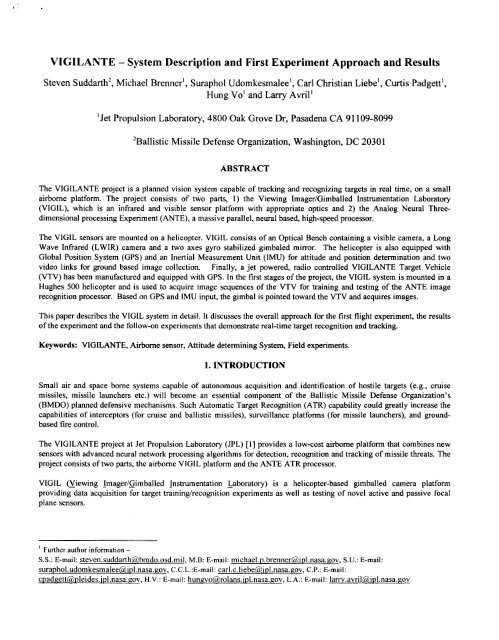
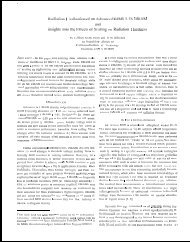


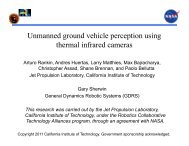



![Ana]ysis of Reaction Products and Conversion Time in the Pyrolysis ...](https://img.yumpu.com/11715548/1/190x242/anaysis-of-reaction-products-and-conversion-time-in-the-pyrolysis-.jpg?quality=85)
